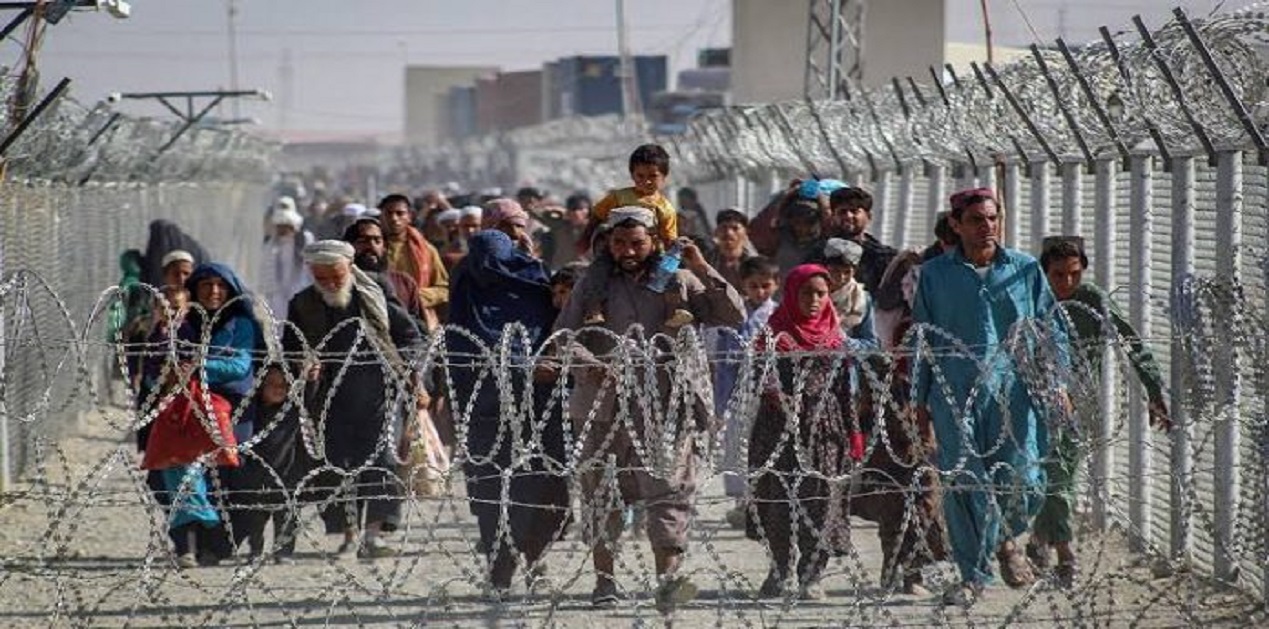Introduction
In recent developments, it has been observed that large scale deportation of Afghan refugees from Iran is in process, after Abdul Rahman Rashid, the Minister of Refugees and Repatriation in Afghanistan, announced that more than 345,000 Afghans are being deported from Iran since the last week of September 2023[1]. The exercise started after Iranian Interior Minister Ahmad Vahidi said on 27 September that 5 million Afghans who were living “illegally” in the Islamic republic will be deported[2]. However, before that in August alone, some 46,000 Afghans returned voluntarily to Afghanistan from Iran, while another 43,000 were deported for a lack of documentation[3], thus increasing the number of returnees at 89,000. Based on information gathered by UNHCR, some 631,000 Afghans were deported from Iran between January and November 2023[4]. Last month, Abdullah Qayomi, head of the ruling Taliban's refugee affairs at the Islam Qala border in Herat said that the daily numbers of Afghans returning from Iran had risen from 1,500-2,000 to 3,000-4,500[5].
Despite vigorously expressing concerns regarding the situation of Shi ‘a minority (notably but not exclusively Hazaras) in Afghanistan in the past several decades, Iran’s treatment towards the immigrants have raised concerns for the former and the surrounding region. There are speculations and interpretations in the academic as well as policy circles as to what has likely been the reason for Iran to repatriate Afghans from their country[6] after giving them asylum for more than 40 years. Regardless of being criticised for causing high economic burden in Iran, it is needless to say that in the past these Afghan refugees were strategic assets for the country. Moreover, hosting these refugee’s fulfilled Iran’s desire to project itself as a responsible Muslim nation in the region. Therefore, the current deportation programme raises several questions on Iran’s equation with Afghanistan, and its current Taliban-led government.
Afghan Immigration to Iran: Security and Strategic Dimension
The emigration of Afghans to Iran has largely been the result of socio-political circumstances (drought, regime changes and wars)—including changes in the economic structures like agricultural seasonal cycles and, the persisting mobile pastoralism across the region[7]. Besides the geographic proximity with Iran, the historical dynamics in their relationship were built on sharing similar language (Dari—the Afghan dialect of the Persian language spoken by a substantial Afghan population), common ethnic groups, partially because Afghanistan is home to an approximately twenty percent of Shia population (represented by the Hazaras and few other groups within Afghanistan)—which is Iran’s dominant sect.
Prior to the Iranian Revolution in 1979, immigration from Afghanistan intensified from 1970s onwards after Iran’s oil boom followed by the extreme drought conditions in Afghanistan during 1971-1972 that saw a large number of Afghan population moving to Iran in the quest of survivability. With the Soviet intervention of Afghanistan in 1979, the problem related to mass movement of Afghans multiplied with migration to the neighbouring countries including, Iran. Under ‘Ruhollah Khomeini’ (the then Supreme Leader), Iran welcomed the Afghans with an “open-door policy”, where these immigrants were entitled to health care, education, food, fuel, rations and were granted opportunities for employment and investment in the country. In many of Khomeini’s public speeches during that period, the leader endorsed the ‘religious obligation’ for Iranians in hosting the fellow Muslims from Afghanistan. Iran’s open-door policy added to the country’s advantage in exerting an ‘ideological influence' over the Shias (especially the Hazaras) from Afghanistan. In addition to hosting the refugees, Iran also covertly participated in the Afghan conflict by supporting the Shia mujahedeen groups, and much of it was driven by the country’s proxy war in West Asia with its ideological rival, Saudi Arabia that was similarly, helping the Sunni Mujahedeen groups with funds. Therefore, the political turbulence in Afghanistan after 1979 added some ideological edge for Iran in hosting 2.9 million Afghan refugees from 1980-1989.
Apart from an ideological connection, there lay a strategic dimension in hosting the Afghan Refugees that began with the formation of ‘Fatemiyoun Division’[8]—which became the pathway to legal and social recognition of the ethnic Afghan Hazara refugees within the Islamic Republic of Iran[9]. The history of this division goes back to 1980s when a group of Ayatollah followers participated in the Afghan war against the Soviet Union[10]. The same group then expanded and fought the Iran-Iraq War and the Afghan civil war in the early 1990s. But after the Soviet withdrawal in 1989, regional dynamics changed for both Iran and Afghanistan. A year before the death of Ayatollah Khomeini in 1989, Iran and Iraq ended their eight-year long war in 1988, followed by the election of Hashemi Rafsanjani to the presidency in 1989. All these events had a gradual influence on Iran’s migration policy as well. The new administration showed interest in rebuilding the war-ravaged county with definite borders and by allowing privatization of a sizeable part of the economy with market-oriented measures for attracting foreign investments[11]. The new economic policies anyhow necessitated the flow of Afghans as ‘cheap labour’ and therefore, for economic reasons, Iran was bound to re/open its open-door policy for the Afghan immigrants. However, domestic, economic and social concerns forced the state of Iran in 1992 to formalize its first repatriation programme for Afghans with the creation of a Tripartite Commission comprising Afghanistan, Iran and UNHCR[12]. Accordingly, 1.4 million Afghans returned from Iran to Afghanistan in 1992. And since 1993, Iran adopted policies that appeared less appealing for Afghan migrants to come to Iran after the state put restrictions on access to free or subsidized resources such as education, energy, and health services.
With the Taliban coming to power in Kabul in 1996, the rise of anti-Shia activities enabled the Afghans to earn sympathy from the Iranian establishment to once again grant them asylum in their country[13]. While the Shia fighters backed by Iran came back to Afghanistan to fight the Taliban regime but, later dissolved and moved back to Iran fearing persecution, especially after the killing of Hazaras in Mazar-e-Sharif by the Taliban in 1998. Therefore, since the beginning of the Afghan war and until the U.S led intervention in 2001, migration to Iran was primarily motivated by the direct and indirect effects of the war, violence, insecurity, and a troubled economy.
In the aftermath of the collapse of the Taliban government in 2001, Mohammad Khatami, the then president of Iran, signed a ‘second repatriation agreement’ with the Afghan government and UNHCR in 2002[14]. Accordingly, the number of documented refugees in Iran reduced from 1.4 million to 7,438,56 during 2004-2005[15]. Despite Iran’s deportation programmes, displacement from parts of Afghanistan into Iran increased after the emergence of the Islamic State (IS) group in Afghanistan in 2014[16]. Moreover since 2015, change in regional dynamics brought the Afghan Shia fighters to Middle East to fulfill Iran’s geo-strategic objectives[17]. Based on reports, it was found that, ‘The Fatemiyoun Army’ was deployed to defend Iranian interests in Syria, Iraq, and Yemen—and becoming the largest and most formidable military group backing Tehran’s ally Bashar al-Assad in the Syrian war and later the Houthis in Yemen[18]. However, the immigration of Afghans to Iran continued after the Taliban took over Kabul in August 2021. In April 2022, Foreign Minister Hossein Amir-Abdollahian said one million more Afghans had entered Iran since the Taliban took power, bringing Iran’s official number of refugees and economic migrants to five million.
Concerns for Repatriating Afghan Refugees after 2021
With the Taliban coming back to power in 2021, Iran’s stand on the takeover and the future relations with Afghanistan emerged from their supreme leader Ayatollah Khameini, who referred the country as ‘brother nation,’ with the same language, religion, and culture and therefore, asked President Ebrahim Raisi to support the Afghan nation[19] in this crucial juncture. Despite sharing similarities, Iran’s position on the Afghan refugees has not changed much from the past and Iran promised to continue with its repatriation programmes for the Afghans. After the Taliban takeover, the large-scale influx of refugees to Iran, (The Iranian Government estimated that over a million Afghans have applied for asylum since then[20]), has further compelled the country to speed up the deportation process. There are different perspectives on Iran’s policy of sending Afghans back to Afghanistan. However, their primary concern seems related to the socio-cultural infiltration and the changes in the economic milieu of the country because of hosting the refugees. Nevertheless, it is also widely believed that Iranian authorities encouraged “the policy of accepting Afghan Shias to address the significant decline in national population growth to 0.72 percent” [21].
In terms of the socio-cultural landscape of Iran, the Afghan immigrants residing in the country—who are often subjected to a western narrative as culturally hostile to modernity are facing a reaction from the Iranians, who are of the opinion that sheltering them is infiltrating the Iranian youth with anti-women and radical beliefs[22]—which in a way transforming the socio-cultural fabric of the country. In fact, several newspapers in Iran have warned about the immigrants’ high birth rate and called it a threat to national security[23]. This cultural stereotyping has led to label the Afghans as socio-cultural burden on Iran. Moreover, since August 2021, the propensity towards associating Afghan refugee with the Taliban, has further complicated the situation for them. As a result, the Afghan refugees often faced harassment and assault at the hands of the locals[24].
Meanwhile, the Iranian State claims that Afghans are causing massive demographic change to their country. As per the United Nations High Commission for Refugees (UNHCR) report in 2022, Iran hosts 4.5 million forcibly displaced people of varying statuses which include: 762,000 refugees (750,000 Afghan Amayesh card holders, 2.6 million refugees-like population, 360,000 resident permit, 267,000 family passport holders and 500,000 undocumented Afghans[25]. This population is also criticised on the ground of lacking proper assimilation into the Iranian culture. However, the counter narrative speaks that the ‘second-generation’ Afghan refugees have widely adapted into the Iranian culture and domestic milieu[26].
Apart from society and culture, Iran’s deporting of Afghan refugees can be approached from the perspective of the former’s deteriorating economic situation. The country’s deepening economic crisis because of sanctions imposed by the United States, after 2018, are posing serious concerns in hosting Afghan refugees[27]. The sanctions are threatening the social security of the refugees by denying them healthcare benefits after an increase in prices of life saving drugs and medicines treating disease in migrants[28]. Such unfortunate situation is being used to create narratives among the locals regarding migrants carrying virus, which is further leading to resentment against Afghan refugees[29]. Moreover, a decree was passed by Iran’s supreme leader in 2015[30] in connection to providing educational benefits to Afghan children (third-generation refugees)—the edict, which is now increasing Iran’s financial burden, especially after 2018[31]. In addition, the economic problems caused by sanctions are denying a vast number of Afghan refugees of their basic rights such as access to job opportunities, the right to education, and health facilities. Tehran has also complained that very little financial assistance has been received by them from the international community, despite hosting millions of Afghans since 1979[32]. Moreover, after Turkey and some European countries tightened their migration policies, Afghans leaving in Iran are finding it difficult in moving to a third country as was seen in the past. It is important here to mention that Iran has been used as a transit country by the Afghans since decades. But at present, in the face of Iran’s growing economic problems, these Afghan refugees are facing involuntary deportations.
Considering the present economic crisis and the treatment towards Afghan refugees, the hardliners are of the opinion that, the deportation is important at a time when the local Iranians are leaving their country amidst social and economic insecurities. With rising unemployment, the Afghans who are engaged in worst-paid jobs are viewed by many Iranians as those who block their access to the labour market and therefore, exerting pressures on the authorities to deport them back[33]. The liberals on the other hand, are promoting Afghan refugees’ accessibility to buy land, and access to education and healthcare services[34].
Implications for Afghanistan
At a time when Afghanistan is undergoing an economic crisis, the repatriation of Afghan refugees from Iran will leave the country with dire consequence. Afghanistan’s economy which is fragile with a weak private sector relies heavily on external support. After the Taliban takeover in 2021, the freezing of Afghan central bank reserves in U.S. accounts, has deprived the Taliban of billions of dollars. Moreover, a ban in opium, cutting down on international aid, and complete alienating women from the economy is exacerbating all possibilities of the country to be caught in a low-level equilibrium that leaves most Afghans poor, hungry and in need of humanitarian assistance[35]. In a situation like this, it can be well understood the severity with return of the Afghan refugees from Iran—causing not just economic burden, but aggravate the devastating humanitarian crisis in Afghanistan, where millions are on the verge of starvation. With Afghan refugees’ deportation from Pakistan, the Taliban government might find it difficult to be able to absorb millions of returning refugees and migrants. Therefore, Taliban authorities have requested all countries hosting Afghan refugees to show restraint and not to deport them forcefully, allowing the former more time to prepare for hosting them in a dignified manner[36]. Nevertheless, the Afghan migrants who are mostly involved in low-paying and labour-intensive jobs—some of them who send remittances back to their families are going to suffer with this deportation[37]. Apart from the economic perspective, there also lies the security dilemma for Afghans, including journalists, activists, and members of the former Afghan government and security forces—who fear reprisals from the Taliban if they are sent back to Afghanistan from host countries. The women migrants living in Iran are going to be the worst sufferers out of all due to Taliban’s restriction in terms of education to Afghan women. Taliban also fears Fatemiyoun’s presence (often viewed as Iran’s proxy) inside Afghanistan—a potential Hazara resistance against the Taliban[38].
Meanwhile, it is important to note that Taliban’s reaction on Iran sending back Afghan refugees has not been that loud when compared to Pakistan. It does not appear that Afghanistan will strain bi-lateral relationship with Iran over the issue of migrants. However, it needs to be seen in the future if the deportation is a pressure tactic from Iran to settle the issue of Helmand water dispute with Afghanistan which led to border clash between the Taliban and Iran’s border guards in May 2023. Iran has been accusing Afghanistan’s Taliban regime for deliberately depriving them sufficient water supply causing water shortages and subsequent power cuts after hydroelectric power stations ran out of supply—affecting the population at large[39]. Amidst rising tension, and Iran’s relationship with Taliban shifting, it will be interesting to see how their relations transform on the issue of Afghan refugees in the near future.
References
[1]Hadia Ziaei (2023), “Over 345,000 Afghan Refugees Deported by Iran in Past 3 Months: Ministry”, Tolo News, December 11, 2023
[2] https://www.rferl.org/a/azadi-briefing-afghan-migrants-deporting-iran-pakistan-russia/32616150.html
[3] https://www.rferl.org/a/afghans-pakistan-deportees-iran-taliban/32678179.html
[4] file:///C:/Users/Angana/Downloads/UNHCR%20External%20Update%20Afghanistan%20Situation%20%2330%20(1).pdf
[5] https://www.rferl.org/a/afghans-pakistan-deportees-iran-taliban/32678179.html
[6]Fidel Rahmati (2023), “Iran enforces entry limits for Afghan refugees across 16 provinces”The Khama Press, December 03, 2023
[7]Fariba Adelkhah and Zuzanna Olszewska (2007), “The Iranian Afghans”, Iranian Studies, Cambridge University Press, 40(2):137:165
[8]TOBIAS SCHNEIDER (2018), “THE FATEMIYOUN DIVISION AFGHAN FIGHTERS IN THE SYRIAN CIVIL WAR”, Middle East Institute
[9]Human Rights Watch Report (2016), “Iran Sending Thousands of Afghans to Fight in Syria”, https://www.hrw.org/news/2016/01/29/iran-sending-thousands-afghans-fight-syria
[10]Ibid
[11]Sussan Siavoshi (2022), “Afghans in Iran: the state and the working of immigration policies”, British Journal of Middle Eastern Studies, Taylor and Francis, https://www.tandfonline.com/doi/full/10.1080/13530194.2022.2113504
[12]The European Commission (EC), the United Nations High Commissioner for Refugees (UNHCR) and Stichting Vluchteling (2005), “RETURN TO AFGHANISTAN? A Study of Afghans Living in Tehran”, https://www.refworld.org/pdfid/47c3f3ca0.pdf
[13]Amin Saikal (2001), “Iran's Turbulent Neighbour: The Challenge of the Taliban”, Global Dialogue, 3(2):93-103, file:///C:/Users/Angana%20Kotokey/Downloads/278c4e6f1caa9ab34690de32e2be18a1.pdf
[14]European Union Agency for Asylum (2022), “Iran-Situation of Afghan Refugees”, EUAA
[15]Ibid
[16]USIP (2016), “The Rise and Stall of the Islamic State in Afghanistan”, https://www.usip.org/sites/default/files/SR395-The-Rise-and-Stall-of-the-Islamic-State-in-Afghanistan.pdf
[17]Amir Toumaj. et.al (2021), “The Fatemiyoun Division & Iran’s Proxy Warfare Propaganda”, https://www.jstor.org/stable/pdf/resrep33428.4.pdf?refreqid=fastly-default%3A3df5869758f4c24000d4e6a9b447636c&ab_segments=&origin=&initiator=&acceptTC=1
[18]Arian Sharifi (2021), “The Fatemiyoun Army: Iran’s Afghan Crusaders in Syria”, The Diplomat, https://thediplomat.com/2021/04/the-fatemiyoun-army-irans-afghan-crusaders-in-syria/
[19] https://english.khamenei.ir/news/8661/We-support-the-nation-of-Afghanistan-Governments-come-go
[20] https://www.iranintl.com/en/202309275945
[21] https://thediplomat.com/2023/11/an-iranian-reversal-on-afghan-refugees/
[22]Iran: Anti-Afghan sentiment is on the rise, Middle East Eye, https://www.middleeasteye.net/news/iran-anti-afghan-sentiment-rise
[23] https://www.stimson.org/2023/the-afghan-immigrant-crisis-in-iran-and-the-rise-of-afghanophobia/
[24] https://www.rferl.org/a/iran-afghanistan-migrants-violence/32643181.html
[25]UNHCR Report (2022), “Overview of Iran”, https://data.unhcr.org/en/country/irn
[26]Abbasi Shavazi, Mohammad; Sadeghi, Rasoul (2011), “Native-immigrant marriage differentials in Iran: Comparative study of marriage behaviors of Afghan immigrants and Iranians”, Journal of Population Association of Iran, Australian National University
[27]Maziar Motamedi(2019), “Could US sanctions on Iran create new migrant crisis for Europe?”, Aljazeera, May 22 2019
[28]Organization for Defending Victims of Violence (ODVV) (2019), “The Impact of Sanctions on Refugees and Migrants in Iran” Report
[29] https://www.stimson.org/2023/the-afghan-immigrant-crisis-in-iran-and-the-rise-of-afghanophobia/#:~:text=Reza%20mentioned%20a%20TV%20show,by%20viral%20social%20media%20posts.
[30]“Khamenei orders schooling for all Afghan children in Iran”, Al- Monitor, May 19 2015
[31]Until 1992, the Iranian administration provided Afghans with “blue cards” for Afghan refugees to have access to free primary and secondary education.
[32] https://www.rferl.org/a/iran-afghanistan-migrants-violence/32643181.html
[33] https://d-nb.info/1265485496/34
[34] https://thediplomat.com/2023/11/an-iranian-reversal-on-afghan-refugees/
[35] https://www.usip.org/publications/2023/08/two-years-taliban-rule-new-shocks-weaken-afghan-economy
[36] https://www.reuters.com/world/asia-pacific/pakistans-plan-expel-over-1-million-afghans-living-country-illegally-2023-10-31/
[37] https://www.rferl.org/a/azadi-briefing-afghan-migrants-deporting-iran-pakistan-russia/32616150.html
[38] https://www.pbs.org/wgbh/frontline/article/what-is-the-fatemiyoun-brigade-and-why-does-it-make-the-taliban-nervous/#:~:text=Who%20are%20the%20Fatemiyoun%3F,total%20population%20of%2038%20million.
[39] https://www.cnbc.com/2023/06/19/afghanistan-iran-border-flare-up-spotlights-water-scarcity-crisis.html
(The paper is the author’s individual scholastic articulation. The author certifies that the article/paper is original in content, unpublished and it has not been submitted for publication/web upload elsewhere, and that the facts and figures quoted are duly referenced, as needed, and are believed to be correct). (The paper does not necessarily represent the organisational stance... More >>
Image Source: https://muslimmirror.com/eng/wp-content/uploads/2023/01/images-61-696x391.jpeg











Post new comment